Special Report
Countries Where People Don’t Get Enough to Eat
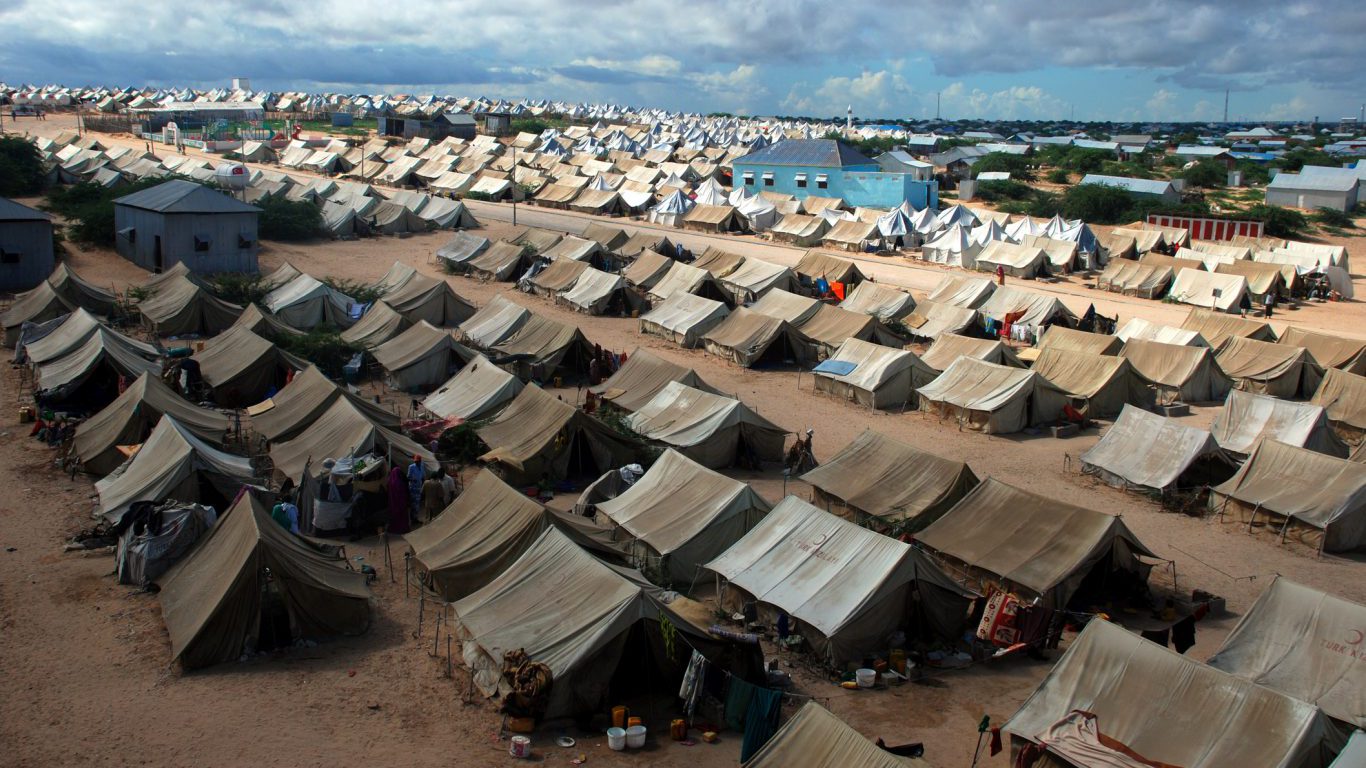
Published:
Last Updated:

As of 2018, 76 low- and middle-income countries around the world received, at some point, food aid from the United States. Many residents in these countries struggle with food insecurity. A recent report estimates that 21.1% of residents in these nations, about 782 million people in all, are food insecure, meaning they do not have access to the recommended 2,100 calories a day.
The U.S. Department of Agriculture’s International Food Security Assessment (IFSA) evaluated food security in these 76 countries in Asia, Latin America and the Caribbean, sub-Saharan Africa, and North Africa.
24/7 Wall St. reviewed the 15 countries with the highest share of the population that is food insecure. At least 45% of the population in these 15 countries is food insecure. In the top five countries, over 80% of the population is food insecure.
Co-author of the USDA’s IFSA, Karen Thome, explained that the report assesses a population’s access to food, incomes, food prices, and current level of food consumption. She also emphasized that the report looks far beyond the availability of food in a region, examining whether a region or a specific country’s market is functioning properly.
Countries facing the highest rate of food insecurity are mostly located in sub-Saharan Africa. There are several reasons driving high food insecurity rates in these countries, including poverty, war, civil unrest, and weather conditions such as drought. Nearly all of the sub-Saharan countries on this list are struggling with most, if not all, of these issues at once.
For example, in Zambia, drought is projected to cut corn production in half this year. In the Democratic Republic of Congo, 4.5 million people have been internally displaced due to war and conflict. Being displaced leaves people without a source of income and severely hinders their ability to afford food.
Click here to see 15 countries where people don’t get enough to eat.
Click here to read our detailed findings and methodology.
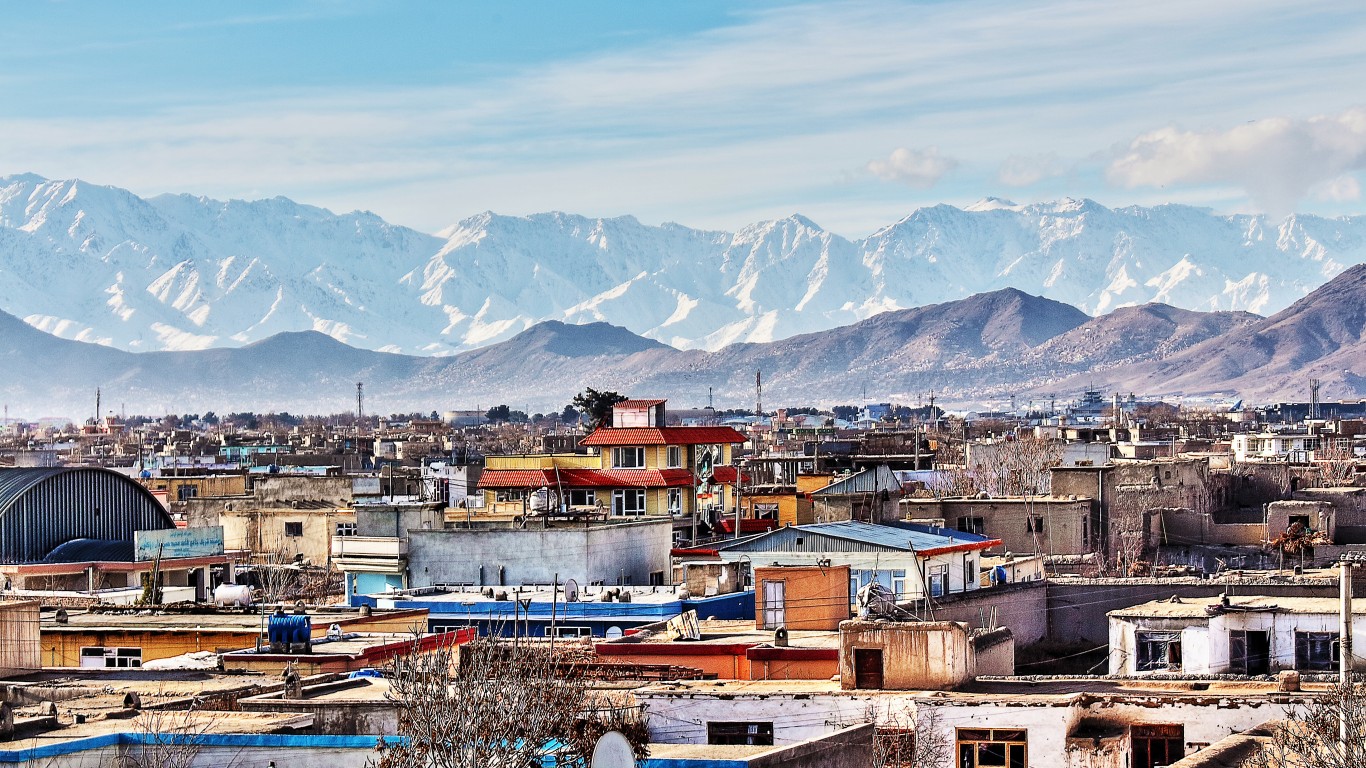
15. Afghanistan
> Pct. food insecure: 45.0%
> Projected pct. food insecure, 2028: 24.5%
> Total population: 34.9 million
Afghanistan is one of the three countries in Asia among the 15 most food insecure countries in the world. An estimated 45.0% of the population in Afghanistan is unable to consume at least 2,100 calories per day, indicating food insecurity. While the nation’s food-insecure population increased from 13.3 million to 15.7 million in the past year, it is projected to decrease to 10.7 million by 2028.
Decades of war and natural disasters, such as earthquakes and landslides, are partially to blame for the country’s high food insecurity rate. Among the countries with data from the World Bank, Afghanistan has the second largest number of battle-related deaths — in 2017, 18,950 people died in battle.
[in-text-ad]

14. Madagascar
> Pct. food insecure: 45.5%
> Projected pct. food insecure, 2028: 24.3%
> Total population: 25.7 million
Madagascar, located about 260 miles off the east coast of southern Africa, is one of the most food insecure countries in the world. Madagascar is one of 11 sub-Saharan countries on this list.
The percentage of food insecure people in Madagascar increased from 41.0% of the population last year to 45.5% this year. Living in a rural area can contribute to low access to food and a relatively high 63.5% of Madagascar’s population lives in rural areas. That share represents a 1.6% increase from 2016.

13. Haiti
> Pct. food insecure: 49.9%
> Projected pct. food insecure, 2028: 30.2%
> Total population: 10.8 million
Haiti is the lone country in the Western Hemisphere on this list — food insecurity plagues nearly half of the country’s population. Poverty, which greatly contributes to food insecurity, is a serious problem in Haiti. According to the World Food Programme, 75% of Haiti’s population lives on less than $2.00 a day.
Haiti also has one of the largest food gaps in the world. The food gap is the difference between the recommended 2,100 calories per day and the average number of calories the average person in the country consumes. Haitians lack, on average, 649 calories per day.
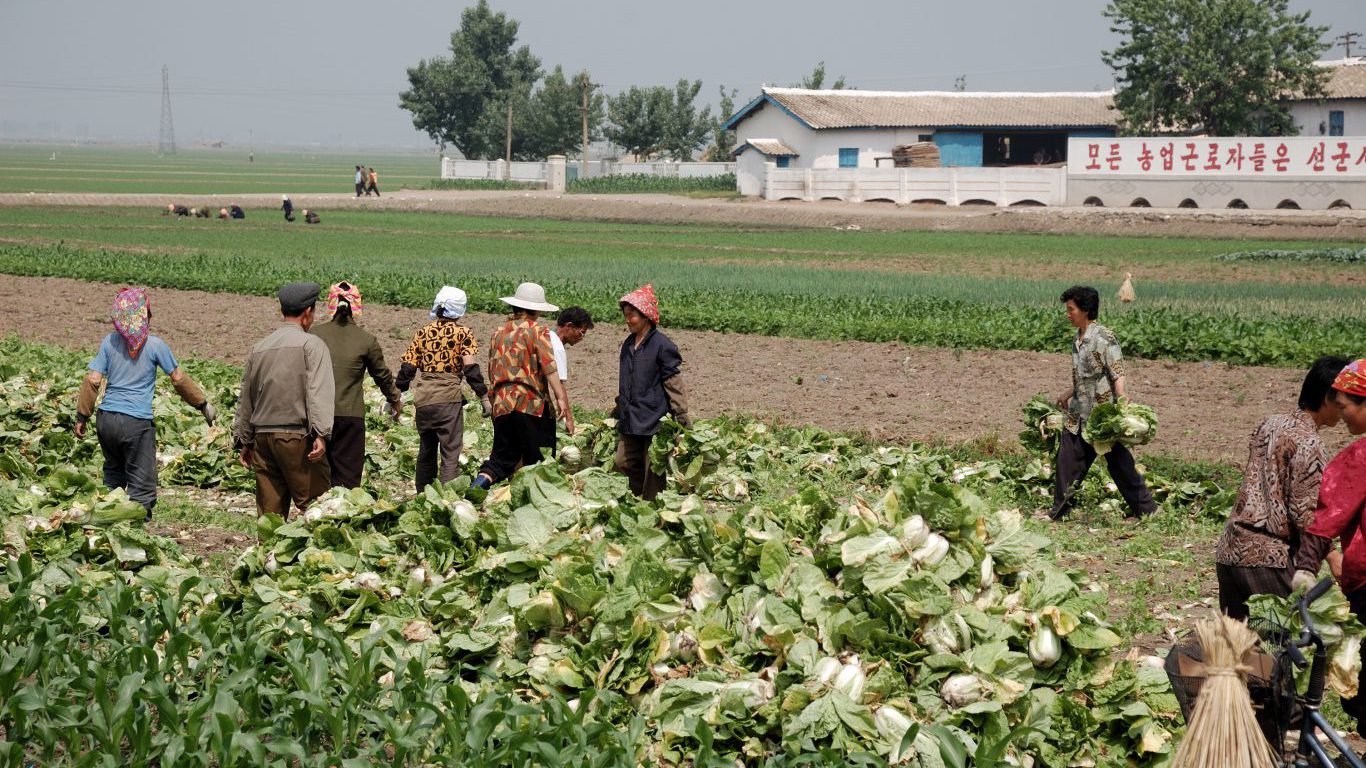
12. North Korea
> Pct. food insecure: 54.1%
> Projected pct. food insecure, 2028: 43.7%
> Total population: 25.4 million
An estimated 54.1% of North Koreans cannot consume the standard 2,100 calories a day. According to the Food and Agriculture Organization of the United Nations, 28% of children in North Korea are stunted, meaning they are abnormally short. The UN describes stunted growth as a reflection of a chronic state of undernutrition. Children who are stunted prior to the age of two are at much higher risk of illness and cognitive delay.
Much like the rest of the world, the share of the population that is food insecure is projected to drop to 43.7% by the end of the decade.
[in-text-ad-2]
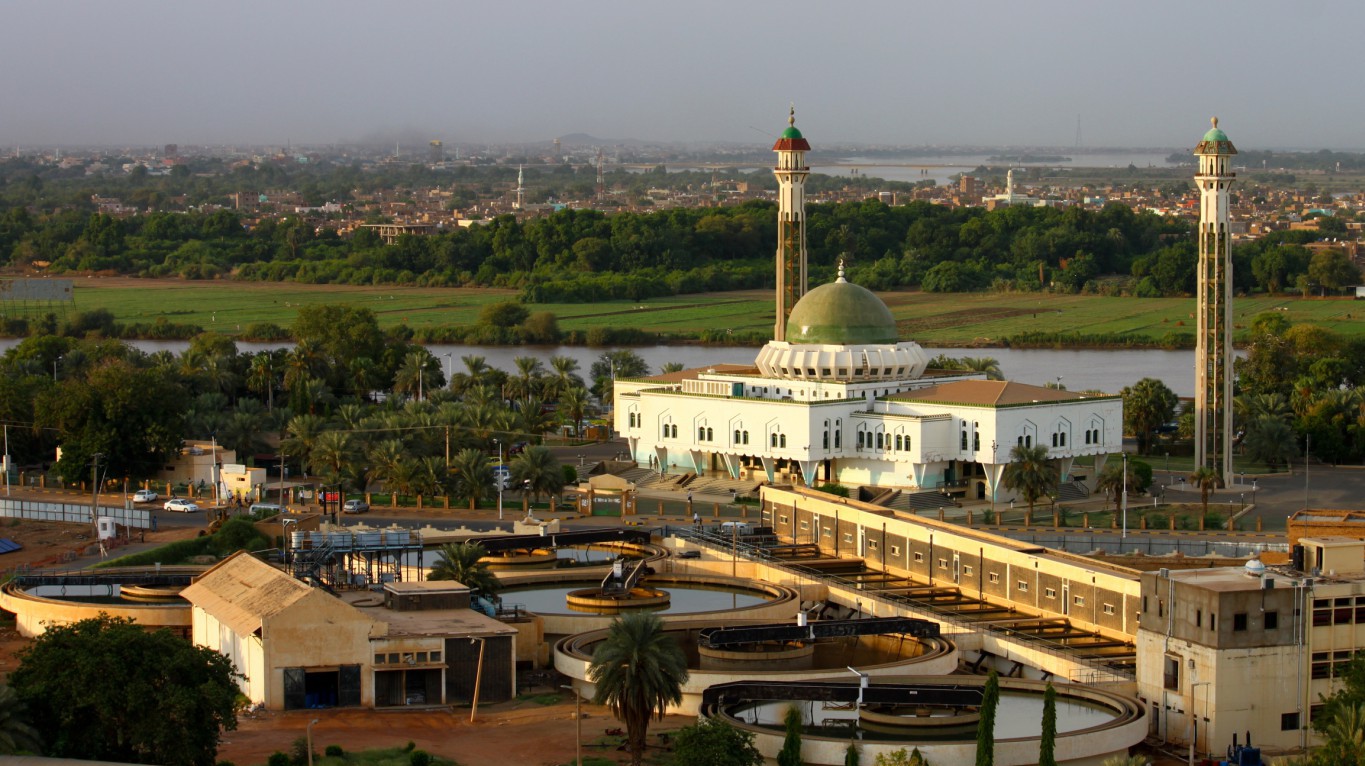
11. Sudan
> Pct. food insecure: 57.2%
> Projected pct. food insecure, 2028: 47.2%
> Total population: 38.0 million
High food insecurity in Sudan is likely the result of the many problems the African nation is facing. An estimated 1.5 million people lost their lives in two civil wars between the northern and southern parts of the country. South Sudan became its own country in 2011. However, unsettled disputes regarding oil revenues and other issues remain, wreaking havoc on the nation’s ability to recover. Nearly 2.1 million people are internally displaced from conflict and violence.
According to USDA, the food insecurity rate in Sudan is projected to drop by 10 percentage points over the next decade.

10. Chad
> Pct. food insecure: 57.4%
> Projected pct. food insecure, 2028: 53.2%
> Total population: 12.3 million
Though Chad’s expanding oil sector contributed to economic growth, it also triggered several conflicts between Chad and neighboring Sudan. In addition, civil unrest also led to increased hunger in Chad — 57.4% of the population is food insecure. Unlike most countries on this list, food insecurity in Chad is not projected to improve by much. By 2028, 53.2% of the people in Chad will be food insecure.
Not having enough to eat can cause starvation and increase the likelihood of serious illness. In Chad, the death rate of 13 per every 1,000 people is one of the highest among all low- and middle-income countries.
[in-text-ad]
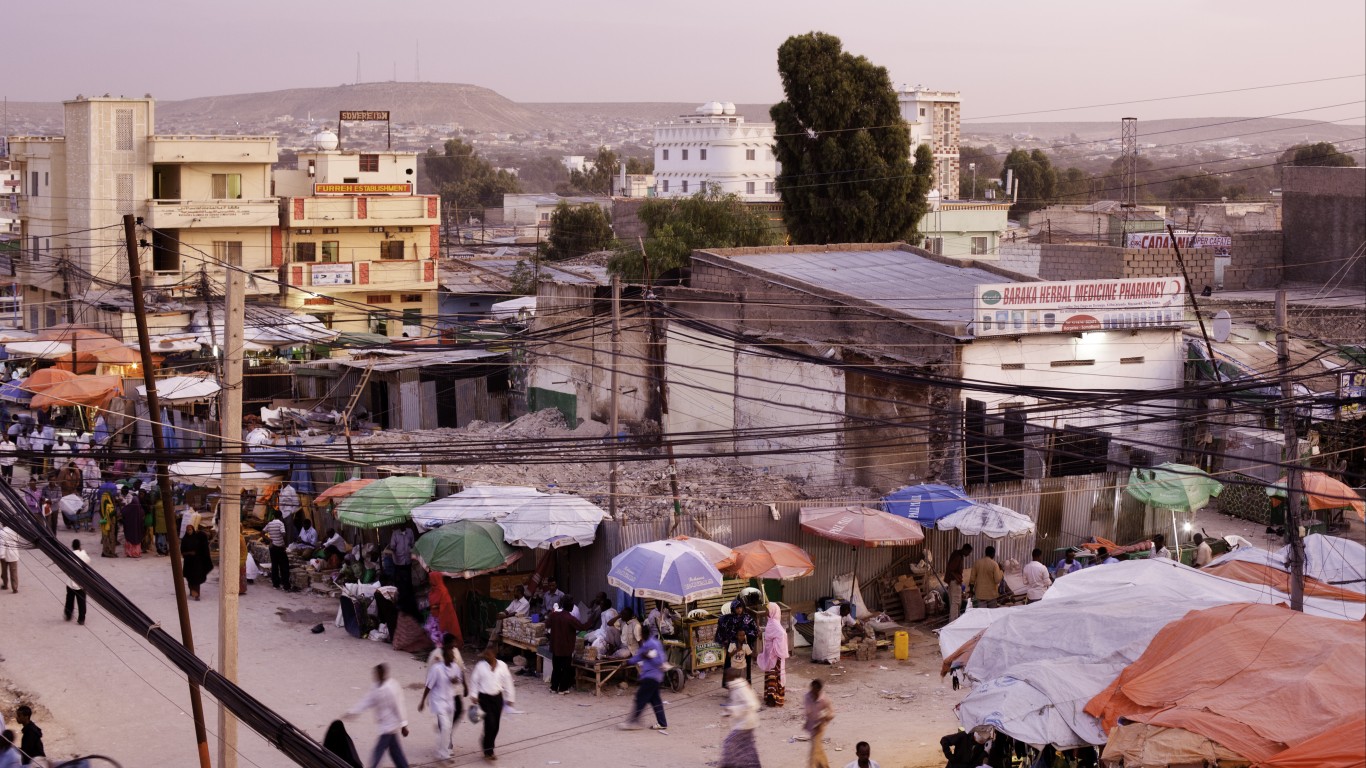
9. Somalia
> Pct. food insecure: 61.5%
> Projected pct. food insecure, 2028: 46.8%
> Total population: 11.3 million
Somalia has been one of the most tumultuous places in the world for the past few decades. The country’s first formal parliament in years was installed in 2012, and the country had its first presidential election after more than 40 years.
While data is limited, the USDA estimates that 61.5% of the population consumes less than 2,100 calories per day. However, with a government installed and making progress against militant groups, food access in Somalia may improve in the next decade. By 2028, the food insecurity rate is projected to drop to 46.8%.
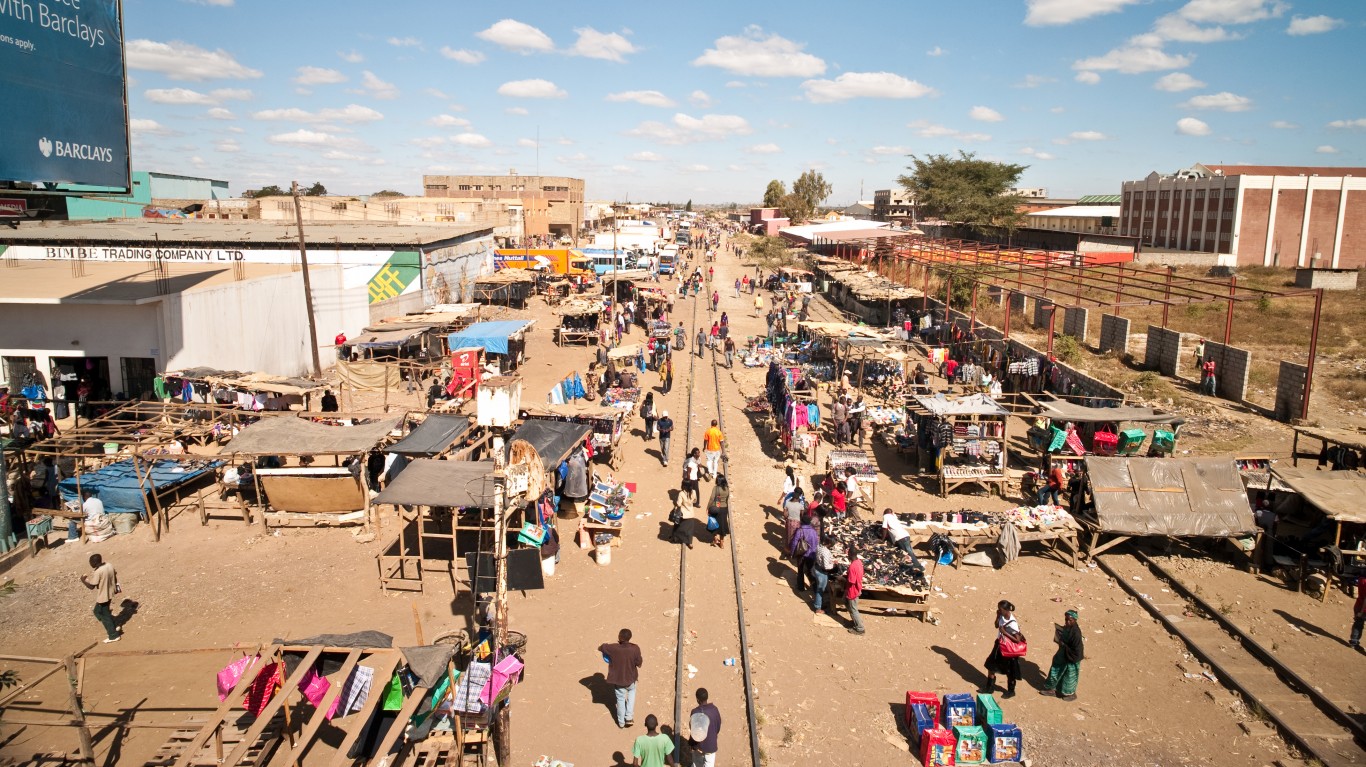
8. Zambia
> Pct. food insecure: 63.3%
> Projected pct. food insecure, 2028: 46.5%
> Total population: 16.4 million
Of the 16.4 million residents of Zambia, 9.7 million live in a rural area. A majority of households depend on corn cultivation, a crop that is susceptible to drought. This year, the severity of the drought has the potential to cut corn output by 50%. Such events contributing to the country’s high food insecurity rate. As of 2017, 63.3% of Zambians have food insecurity.
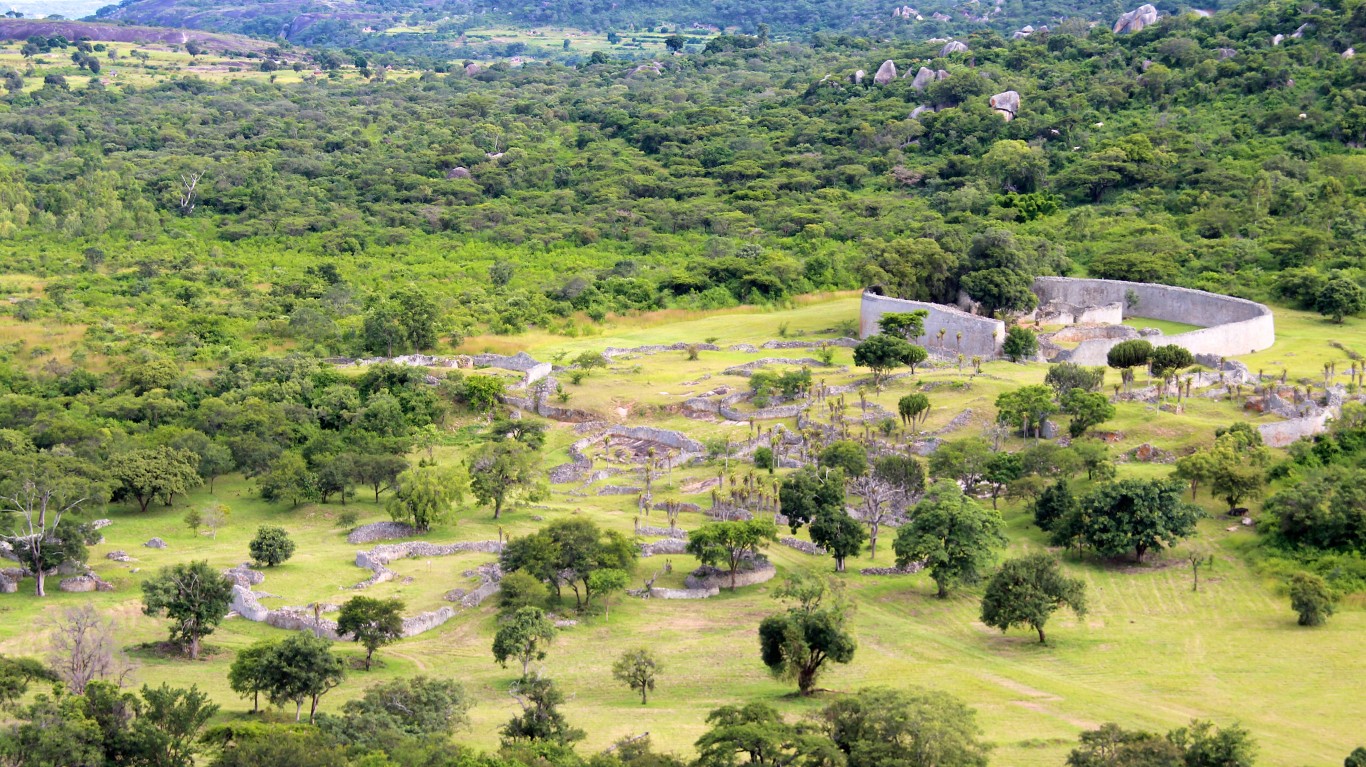
7. Zimbabwe
> Pct. food insecure: 63.4%
> Projected pct. food insecure, 2028: 77.5%
> Total population: 14.0 million
About 63.4% of Zimbabwe’s population is food insecure, the seventh highest share of food insecurity among the 76 nations that have a history of receiving food aid from the United States. Unlike a majority of low- and middle-income countries considered, the USDA predicts the food insecurity rate in Zimbabwe will increase by over a dozen percentage points over the next decade. This is likely due to problems in Zimbabwe’s agriculture sector. The country has struggled with an enduring severe drought, which reduced the yield of crops.
[in-text-ad-2]
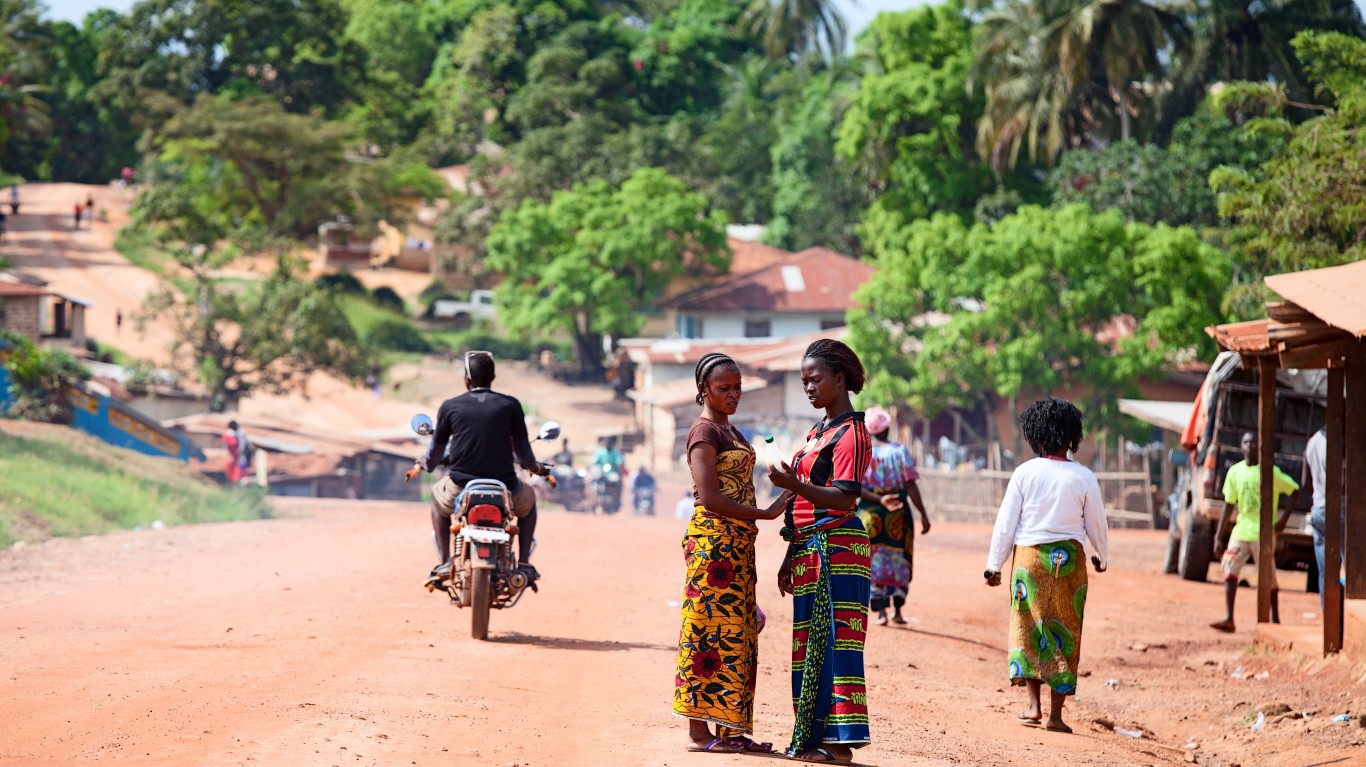
6. Liberia
> Pct. food insecure: 70.7%
> Projected pct. food insecure, 2028: 55.0%
> Total population: 4.8 million
The food insecurity rate in Liberia remained effectively the same between this year and last at 70.7%. Nearly half of the country’s population, or 2.3 million, lives in rural parts of the country, where poverty and food insecurity are most prevalent. Liberia depends on foreign aid and investment. Liberians rely heavily on fish for protein as livestock production is small scale and inadequate to feed the whole population.
Liberia also has the second largest food gap among the 76 countries that have historically received food aid from the United States. Liberians on average consume 714 calories less than the recommended 2,100 daily calories.

5. DR Congo
> Pct. food insecure: 83.9%
> Projected pct. food insecure, 2028: 75.2%
> Total population: 85.3 million
Nearly 84% of the population of the Democratic Republic of Congo is unable to consume the recommended 2,100 calories a day. Recurring violence and conflict in the country has led to significant population displacement, a common cause of food insecurity. Currently, 4.5 million Congolese have been forced to flee their homes and live elsewhere in the country.
The typical person from DR Congo eats about 1,159 calories day, a 941 calorie-difference from the recommended 2,100 calories. This is the largest food gap among all 76 countries considered.
[in-text-ad]

4. The Central African Republic
> Pct. food insecure: 84.1%
> Projected pct. food insecure, 2028: 80.7%
> Total population: 5.7 million
The Central African Republic’s food security issues worsened significantly in 2012, when violence from the 2004 CAR Bush War resurged. Roughly 84.1% of the country’s population struggles to get a sufficient amount to eat.
The ongoing conflict and the problems that have arisen from it — including food insecurity — poses serious risks to the health of the country’s population. CAR has the highest death rate of all 76 low- and middle-income countries considered, at 14 out of every 1,000 people each year.
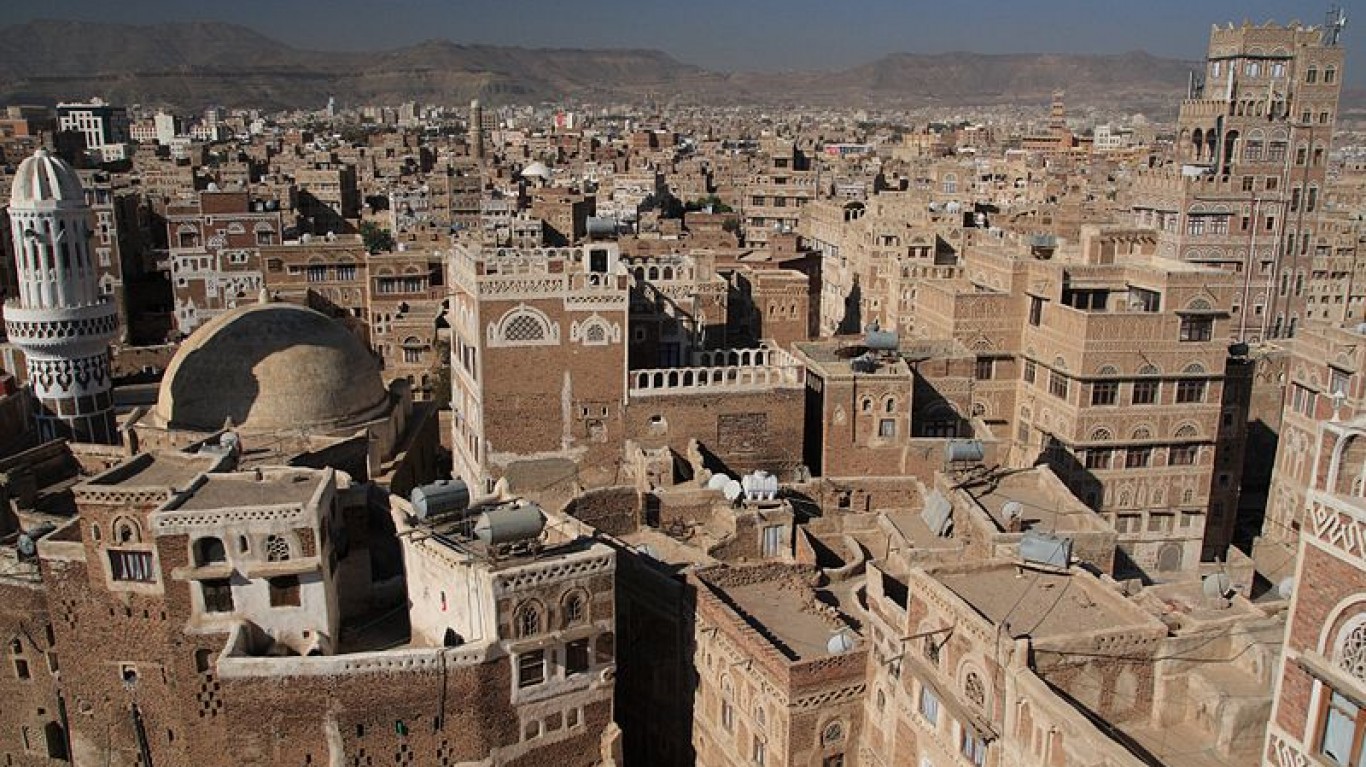
3. Yemen
> Pct. food insecure: 86.0%
> Projected pct. food insecure, 2028: 77.7%
> Total population: 28.7 million
Last year, Yemen was the most food insecure nation among the 76 countries that have received food aid from the United States, with 88.3% of the population not having enough to eat. This year, that rate dropped slightly to 86.0%, which pushed the country back to the third most food insecure. Yemen is in the midst of a civil war, with ongoing aerial bombings by Saudi Arabia. The war has effectively destroyed the country’s economy and led to the displacement of about 2 million. Hundreds of thousands of Yemeni children are starving as a result.
The USDA predicts that in a decade, the food insecurity rate in Yemen will drop to 77.7%.
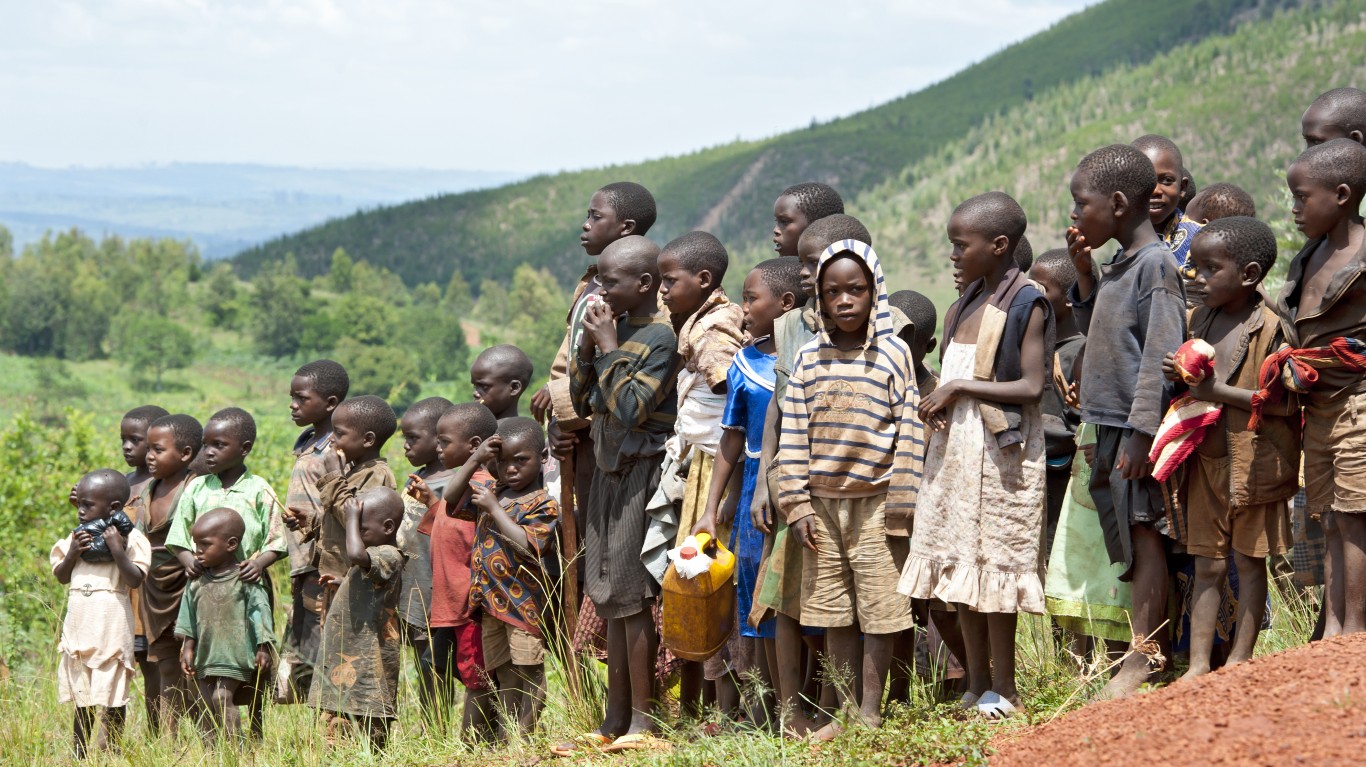
2. Burundi
> Pct. food insecure: 87.2%
> Projected pct. food insecure, 2028: 90.0%
> Total population: 11.8 million
Like many sub-Saharan African countries on this list, political unrest is a driving factor in food insecurity in Burundi. As a country that has been in the midst of an ongoing political crisis since 2015, more than 87% of the population is food insecure — a 7 percentage point increase from the year prior. The country has been mired in an internal political conflict since President Pierre Nkurunziza was elected into his third term three years ago. As a result, many were killed and displaced. Unlike many of the countries on this list, problems with access to a sufficient diet are expected to worsen in Burundi in the coming years. The USDA projects that by 2028, the food insecurity rate will increase to 90.0%.
[in-text-ad-2]

1. Eritrea
> Pct. food insecure: 90.4%
> Projected pct. food insecure, 2028: 89.0%
> Total population: 6.0 million
Eritrea is the most food insecure nation among the 76 low- and middle-income nations that have a history of food aid from the United States. More than 90% of the population has insufficient access to food. After a war that spanned 30 years, Eritrea finally gained independence from Ethiopia in 1993. However, ongoing conflict along with drought has crippled the country’s agriculture-based economy.
If the USDA estimates prove to be true, the future for Eritrea remains bleak. The USDA projects that the food insecurity rate will only improve by 1.4 percentage points by 2028.
Detailed Findings & Methodology
Income plays a pivotal role in food security. For some countries, chronic food insecurity is primarily driven by poverty, Thome explained. According to data from global humanitarian organization Action Against Hunger, an estimated 383 million people in Africa are living on less than $1.90 a day. One factor preventing residents in a number of countries from earning steady incomes is ongoing armed conflict.
Civil unrest is a serious issue in sub-Saharan African countries, which comprise 11 of the 15 most food insecure countries on this list. War is highly disruptive to regional food production and supply. It also displaces millions, disrupting their sources of income. Thome said that many of the countries on this list “have a lot of challenges with conflict or civil unrest. So, not only does this physically disrupt the market, but it also affects or diminishes people’s livelihood.”
While the situations of many of these food-insecure nations may seem bleak, Thome expressed some optimism. She noted that prices of agricultural commodities “are relatively low and stable right now and that’s projected to continue, so that helps people because food is cheaper.”
Reviewing strong GDP growth projections in a number of low- and middle-income countries has also given Thome reason to believe that food security is attainable for some nations. Thome says that incomes in southern Asia, particularly Southeast Asia, have been on a steady incline.
Incomes are also growing quickly in West Africa and parts of East Africa. Thome predicts that this positive change in economic growth patterns will improve food security in these regions.
“As long as this economic growth is spreading around all people, then you’re going to see improvements in food security,” said Thome.
To determine the countries struggling the most with food insecurity, 24/7 Wall St. reviewed the percentage of the population that lacks access to the recommended daily 2,100 calories, according to the U.S. Department of Agriculture’s International Food Security Assessment. We also considered a variety of social and economic data, such as GDP, agricultural production, and the share of residents in rural locations, from institutions like the World Bank and the International Monetary Fund. All figures listed are the most current for each country.
Want retirement to come a few years earlier than you’d planned? Or are you ready to retire now, but want an extra set of eyes on your finances?
Now you can speak with up to 3 financial experts in your area for FREE. By simply clicking here you can begin to match with financial professionals who can help you build your plan to retire early. And the best part? The first conversation with them is free.
Click here to match with up to 3 financial pros who would be excited to help you make financial decisions.
Thank you for reading! Have some feedback for us?
Contact the 24/7 Wall St. editorial team.